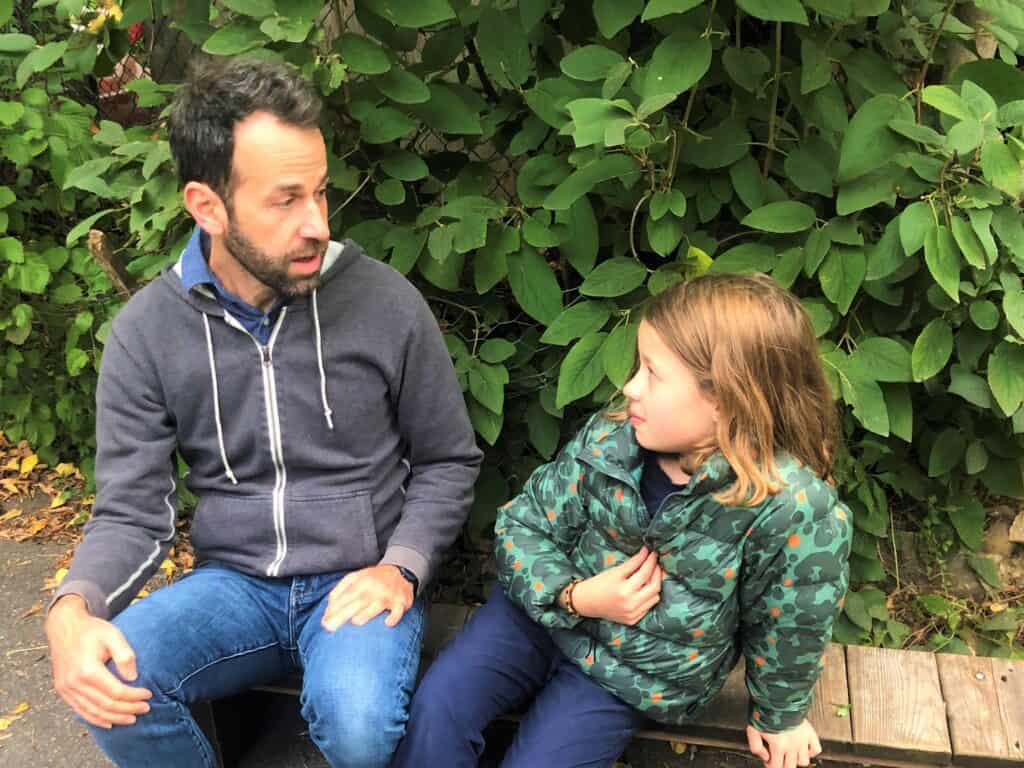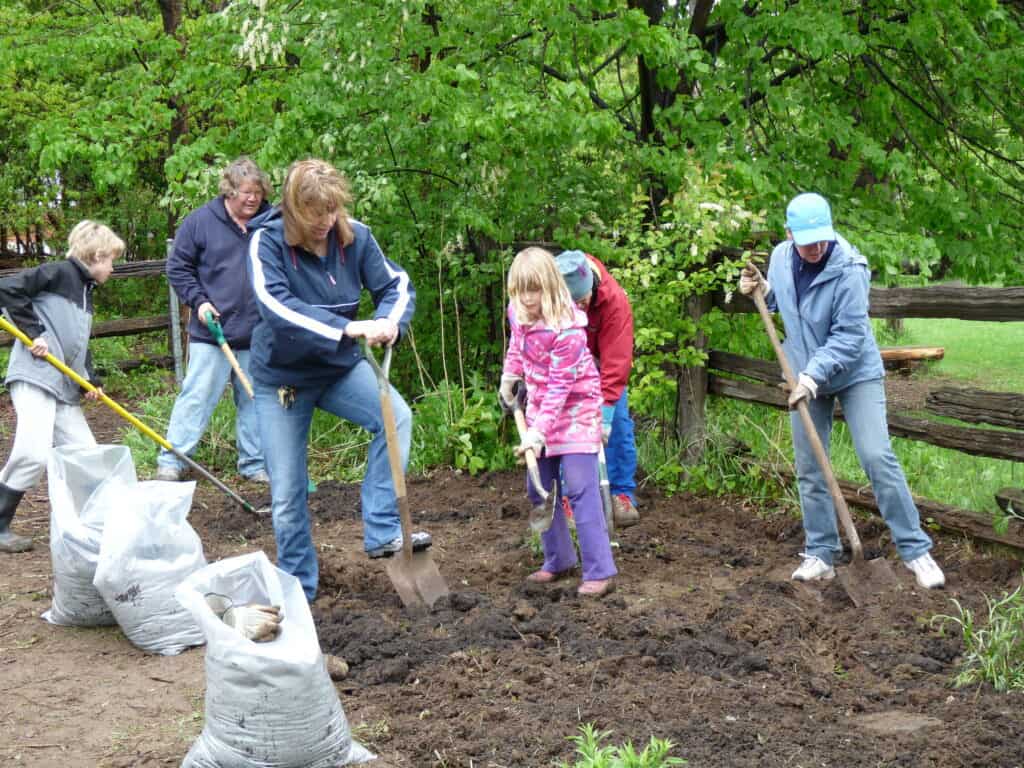Peterborough Examiner – October 8, 2021 – by Drew Monkman
Many children are already anxious or have dangerous misconceptions. They want and need to talk about it.
For nearly two years now, we’ve all been talking non-stop about Covid with friends, family, and even our kids. You’d almost think we’ve all become amateur epidemiologists. These conversations are healthy and help us cope.
However, there is something paradoxical here. Why is it that we don’t have these kind of conversations when it comes to a much larger threat to our future? That threat, of course, is climate chaos. Yes, the media is talking about it more than ever, but very few of us actually broach the topic in any meaningful way with others. Despite the science and devastating impacts being crystal clear – to wit, August’s terrifying IPCC report – the topic almost seems like a no-go zone. This is not healthy. It is also a damaging disservice to our children.
As a parent, grandparent, and retired teacher, I feel it’s absolutely necessary that children have an understanding of why the climate is changing, what the impacts are, and how to take action. Both knowledge and a greater sense of agency are prerequisites to children developing the emotional resilience to cope with the worsening climate impacts that are coming.

Climate education in Ontario
Unfortunately, climate education remains something of an after-thought in the Ontario curriculum. It is not well integrated in the various subjects or across different grades. There is almost nothing from grades K to 6. What’s also lacking is a focus on solutions and helping students develop the skills and initiative to take action.
A study released in 2020 by Lakehead University found that most Ontario students have little faith that anything can be done to solve the climate crisis. This mindset is concerning, because it’s having an impact on young people’s mental health and how they frame their future.
One barrier to teaching kids about climate change is teacher confidence. “[For] the majority of teachers who aren’t talking about climate change in the classroom, it’s not that they disagree it is an important issue; it’s that they lack the understanding to speak confidently about it to their students,” observes Anne Corkery, a Grade 6 and 7 teacher at St. Anne Catholic Elementary School here in Peterborough. Corkery was the recipient of a 2020 LSF Earth Steward Teaching Award for her work on engaging students with climate change.
Talking about climate change
Given that schools are not fulfilling the climate education role, parents need to take this on themselves. The urgency could not be greater. Many children are already anxious or have dangerous misconceptions. They want and need to talk about what they’re seeing and hearing. There are a host of ways parents can talk to their children about what’s going on and ease the climate anxiety that they may have. Here are a few guidelines.
- These conversations are appropriate for children of all ages. Even the youngest children have a sense that climate chaos is shifting things for the worse in the world around them. Yes, this kind of conversation may seem difficult, but it’s no different from talking about things like divorce or death. You simply find ways to do so.
- Brush up on the basic science and solutions ahead of time. However, there’s no need to be an expert. You and your child can also learn together with resources like NASA’s interactive Climate Kids website at https://climatekids.nasa.gov/ . You can also use the “Climate Change 101” below to get started.
- Start by asking your child what they already know. It’s likely more than you think.
- Acknowledge feelings of sadness and anxiety. Assure your child that these are normal and help inspire solutions.
- Give kids reasons for hope and ways to take action but be sure to acknowledge the challenges. Mention what your family is already doing and what you can do in the future. Kids are energized by both family and individual actions, because it allows them to feel a sense of control.
- Don’t give the impression, however, that individual action will be enough. Emphasize that real solutions are provided by collective actions such as new laws, regulations, and who we elect as leaders. Point out inspiring examples of collective solutions already happening like Canada’s carbon tax and the pledge to reduce greenhouse gas emissions by at least 40 percent by 2030. Remind your kids that they’re part of a much broader movement happening around the world.
- On-going conversations are essential. As climate chaos makes extreme weather events more commonplace, use these events to talk about climate issues again. Visceral events like wildfires, floods, extreme heat, and species loss can be scary, but they also open the door for conversation. Websites such as https://www.dailyclimate.org/ will keep you abreast of the latest climate news.
- Consider doing some climate-related activities as a family. A few ideas are provided below.
Climate change 101 for kids
Climate change describes a change in the typical weather for a region — such as temperatures and rainfall — over 30 years or more. Scientists have found that the Earth is heating up very quickly. This is because there are now more gases in the Earth’s atmosphere like carbon dioxide (CO2) that trap heat from the Sun, just like the glass roof and walls of a greenhouse do.
By far the biggest cause of climate change is humans burning fossil fuels like oil, gas, and coal. Here’s why. All plants and animals contain carbon. When they die, they often get buried in the ground. Over a very long time, their underground remains can turn into fossil fuels full of carbon. When we burn these fuels, the carbon goes into the air as an invisible gas called CO2.
The Earth’s climate has changed before but never this quickly. Our planet’s average temperature has already gone up by 1.2 Celsius. This might not sound like much, but the impacts are huge. It is causing more extreme heat, floods, wildfires and the loss of glaciers and sea ice. This is making life more difficult for humans, along with Earth’s plants and animals. People all over the world are working hard to stop the climate from heating up even more.
Some climate activities
The following activities not only help connect kids to nature, but they include an element of climate action and learning.
- Get outdoors with your children as much as possible. This can also be a great role for grandparents. Together, find out more about who resides in your own “neighbourwood.” Remind them that the natural world is part of their family, and not simply a resource to be used to meet human needs. Children will have a better understanding of the importance of protecting the natural world if they have a deeper appreciation of the services, beauty, and wonder it provides. This can also lead to a discussion about the need to make changes in how we live.
- With autumn upon us, take time to explore the forest and its kaleidoscope of colours. Collect conifer needles, cones, leaves, and tree seeds and nuts for a fall nature table or for Thanksgiving and Christmas decorations. Discuss how climate change is impacting our forests.
- Take part as a family in public climate events. If you have older children, watch documentaries together like ‘Breaking Boundaries’ on Netflix. There are also excellent children’s books on climate change like “The Tantrum that Saved the World” by Megan Herbert and “Earth Heroes” by Lily Dyu.
- Make and maintain a bird feeder. Bird populations will be greatly affected by changes in the climate.
- Butterflies like monarchs are also vulnerable. To help them cope, design and plant a pollinator garden with species such as milkweeds. Fall is a great time to plant.
- Celebrate Halloween by wearing “naturized” costumes. Attach natural objects like pine needles and twigs with leaves to costumes or even dress up as a climate-vulnerable animal.
- Make and decorate Christmas cards on the theme of climate change. Send them to friends and family. Include a personal message about feelings and hopes for the future.
- Research and then plant a tree that will thrive in a warming climate. Kids love this activity, and it can lead to great conversations.

As the impacts of climate chaos increase in number and severity, it will be impossible to shelter children from what’s going on. That’s why it’s important to talk about it regularly, to emphasize that we’re all in this together, and to remind them of the many ways to get engaged. We can’t completely cure the anxiety, but we will all feel better if we talk about it – children and adults alike.